How to Travel with a Cat to Europe from USA
Wondering how to travel with your pet from USA to Europe in 2025? It may sound daunting at first, but it’s actually a pretty easy process.
If you’ve been following me on Instagram for a while, you must have seen that my cat, Poofy, is a great travel cat. He travels with us on planes, goes on road trips and walks on a leash like a dog. But, we’ve only traveled with him around the US before, as he was born in Colorado.
Unsurprisingly, when we moved to Europe for the first time in 2019, Poofy came with us straight away. One of the most popular questions became: How did you move with a cat to Europe? We moved again in 2022 and brought the cat back multiple times. In fact, he’s just moved back to Europe with us again this year and has been to 10 countries so far!
Let me tell you that if you’re coming from the US to Europ,e transporting your pet couldn’t be easier. Here is how to do it.
Quick Tip: If you’re already planning your pet’s travel diet, you might be wondering whether cats can eat apples or can dogs eat strawberries? The answer is yes—in moderation! They’re a healthy, low-calorie treat, just be sure to avoid added sugar or syrup.
How to Travel with Cat from the US to Europe
Many people prefer to hire a company specializing in pet transportation, but after I saw their prices I found it ridiculous. It’s so easy to transport pets on your own and arrange all the necessary paperwork for less than $400, that there’s no point in paying someone $1000-35000 to do it for you. It feels like a robbery to me.
Unless you have some exotic pets or breeds that are banned from some airlines or have to transport over 3 pets at once, there’s no point in hiring a company to do it for you.
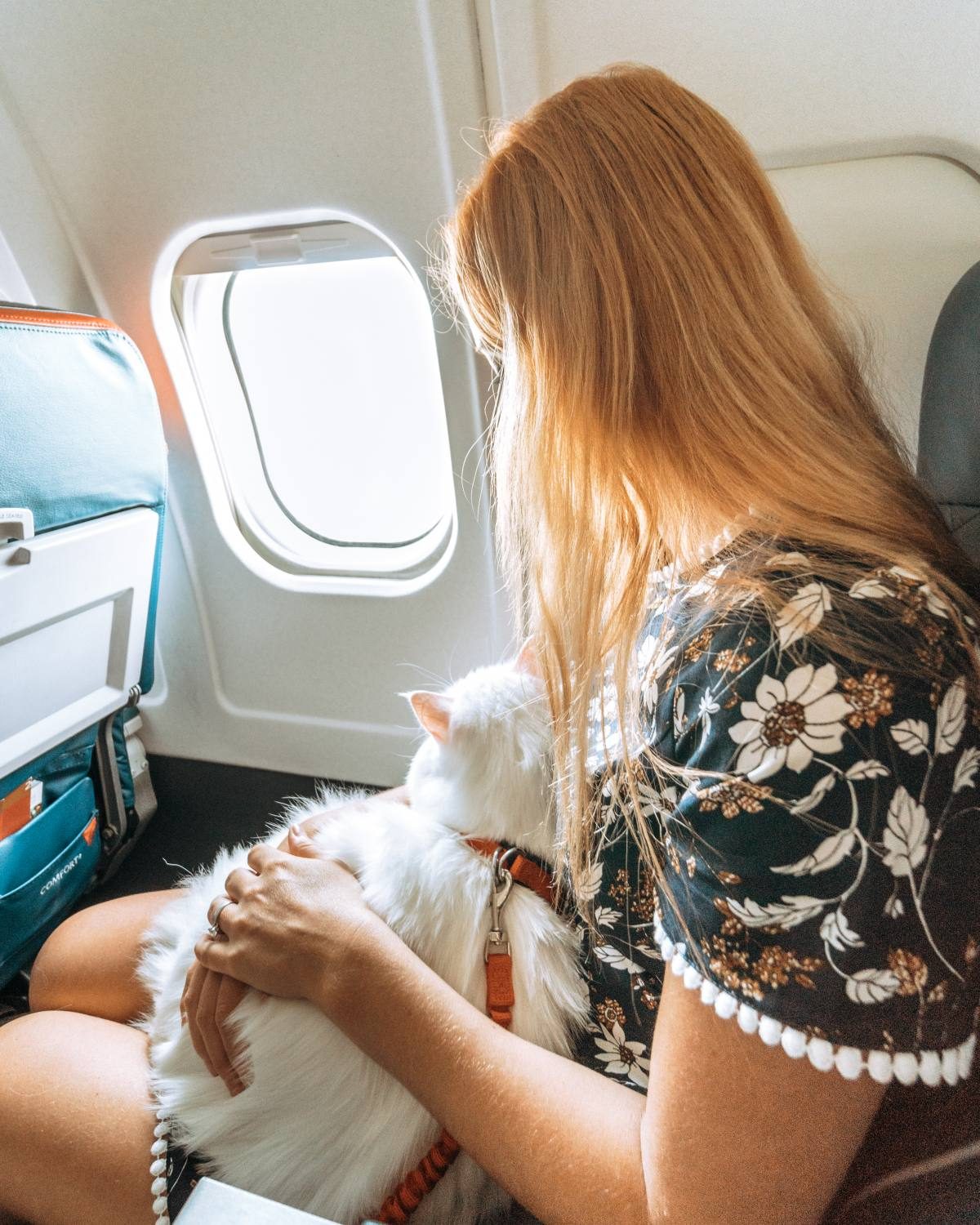
Where Can My Pet Travel With Me in Europe?
Most EU countries have pretty straightforward rules, except Ireland, the United Kingdom, and Iceland. These countries require all pets to arrive in cargo instead of the cabin.
However, some airlines have banned 21 dog breeds and 4 cat breeds as they’re more sensitive. If your pet is on this list below, you might want to check directly to find out how to proceed.
For instance, Lufthansa asks you to sign a form stating that you take full responsibility if your pet dies.
Potentially banned or problematic breeds:
Dog Breeds
- Affenpinscher
- American Bully
- American Pit Bull Terrier
- Amstaff
- Belgian Malinois
- Boston Terrier
- Boxer
- Brussels Griffon
- Bulldog
- Cavalier King Charles Spaniel
- Chow Chow
- English Toy Spaniel/Prince Charles Spaniel
- Japanese Chin/Japanese Spaniel
- Lhasa Apso
- Mastiff
- Pekingese
- Pug
- Shar-Pei/Chinese Shar-Pei
- Shih-Tzu
- Staffordshire Bull Terrier/”Staffys”
- Tibetan Spaniel
Cat Breeds
- Burmese
- Exotic Shorthair
- Himalayan
- Persian

Can My Pet Travel in the Cabin with Me?
When you want to travel with your pet, the first thing you need to figure out it whether your pet will be able to travel with you in a cabin or has to be shipped as cargo.
This depends on the airline, size, type of animal, and country you’re traveling to. If you’re traveling to any of the countries from the list below (even when it’s just transit to your final destination), you can only ship your pet in cargo:
- Australia
- Barbados
- Dakar
- Dubai
- Hong Kong
- Iceland
- Ireland
- Jamaica
- New Zealand
- Republic of Ireland
- South Africa
- United Kingdom
- United Arab Emirates
Pick an airline accordingly, as some as more pet-friendly than others. I can only speak for Delta, LOT, ITA, KLM, and Lufthansa on long-haul flights, as I’ve flown my cat with them on several occasions, but I also heard that Turkish Airlines is great for pet travel. KLM even has a special pet terminal in Amsterdam where you can go and visit your pet traveling in cargo.
Requirements to travel in-cabin:
If your pet is small enough (under 8kg / 17 lbs) avoid cargo at all costs. I heard multiple stories from people whose pets almost got lost and whose posts did get lost.
For any other destination, especially in continental Europe, small dogs, cats, and household birds can travel in the cabin for a one-way fee, usually collected at check-in.
They require a container and officially should remain in them for the duration of the flight, but it’s not a strict rule that’s always enforced if the animal behaves and doesn’t bother other passengers.
Poofy is actually better outside of the carrier, but knows that I can pet him so he usually sleeps and chills in it.
Full Disclosure: The way your pet travels obviously depends on your pet, airline, staff, and situation. If your cat is nervous, doesn’t walk on a leash, and isn’t used to people, don’t ever let him out of his container. Poofy is a bit special, unusually calm, and never bothers anyone – in fact, everyone just wants to pet him.
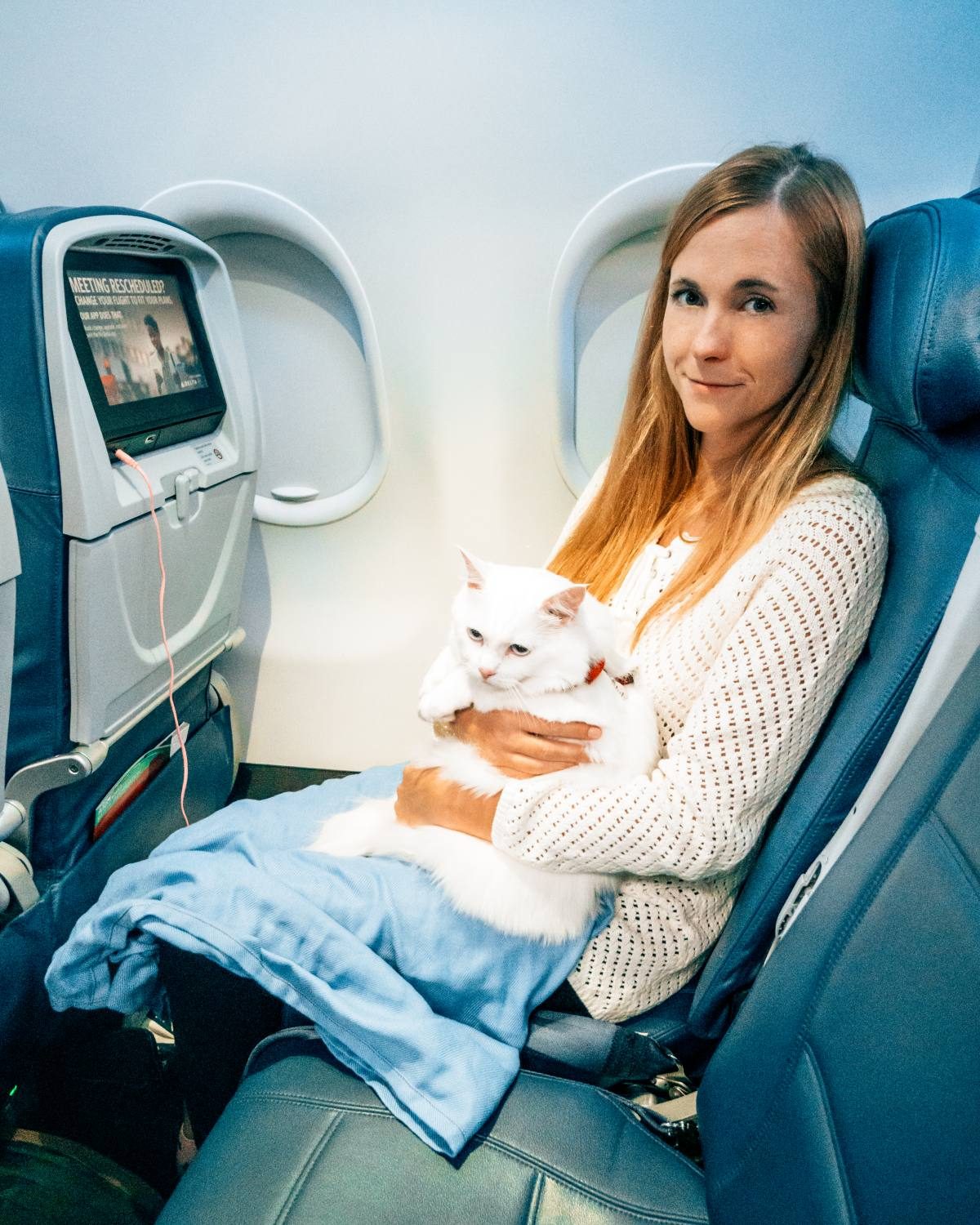
How to Book Your Pet’s Plane ‘Ticket’?
Each airline only allows a certain amount of pets in the cabin (either 2 or 4 depending on the aircraft), so the moment you book your flight call the airline and book your pet in. The agent will ask you about the weight of your pet, his age, and the dimensions of the kennel.
You’ll be required to pay a pet fee at the airport upon check-in. For US domestic flights the fee is usually around $125 each way, including stopovers.
Internationally, if your pet travels in the cabin or kennel in cargo it’s about $200-350, BUT only if you fly directly to your destination and not change an airlines (including co-shared flights). Otherwise, you will have to pay a pet fee again.
Another detail of traveling in-cabin with your pet is that pets cannot fly business or first class on some airlines. If you’re flying with a baby or toddler on top of your pet (basically what we do every single time), technically your pet cannot “sit” in the bulkhead row where the bassinet is or at an emergency exit (because nothing can stay on the ground).
However, Lufthansa moved us to bassinet seats twice automatically in their system, having an amazed flight attendant, but Poofy just rode on the seat with us, and the baby slept in the bassinet.

Pet Travel Requirements for International Travel: Plan at Least 30 days in Advance
There’s no quarantine for pets coming to/from the EU from/to the US, so you don’t have to worry about it. You can bring your pet home straight away.
Other rules are very straightforward: rabies vaccine, microchip, and a USDA vet’s certificate.
Step 1: Microchip: 30+ Days Before Departure
Your pet must be 16 weeks old if traveling to the U.S. from other countries and must be at least 15 weeks old for European Union travel.
If your pet isn’t a microchipped, that will be your first step. The microchip must be implanted before the rabies vaccine is given, so you cannot really do it all in one go. A rabies vaccine given prior to microchip insertion is invalid and your pet won’t be able to travel.
For Europe specifically, your pet must have an “ISO 11784/11785 compliant 15-digit microchip”. I’m saying officially because if you microchip your pet before, most vets will give it a pass without giving him a second microchip – we got a pass, but it’s better to be safe than sorry.
Poofy was microchipped and vaccinated shortly after he turned 4 months old, so we didn’t have to do it again.
Step 2: Rabies Vaccine: 30 Days Before Departure
Even if your pet is entering from a “rabies-free” country (US is considered rabies-free), it will still need a rabies vaccination after microchipping. The vaccination must be done more than 21 days before entering the country.
If your pet already has a valid rabies vaccine, you don’t need to get it again.
Step 3: Get a Veterinary Certificate: 10 Days or Less Before Departure
You will also need to arrange a Veterinary Certificate filled by the vet who’s USDA certified. Call your vet and ask if they have anyone, and if not, they’ll point you to another place.
The Veterinary Certificate must be filled in by a licensed veterinarian within 10 days of your flight out. These days it’s done entirely online by the vet, and it will be overnighted to you from the USDA with a stamp.
This EU Health Certificate is valid for 4 months, so you can travel within Europe freely with it.
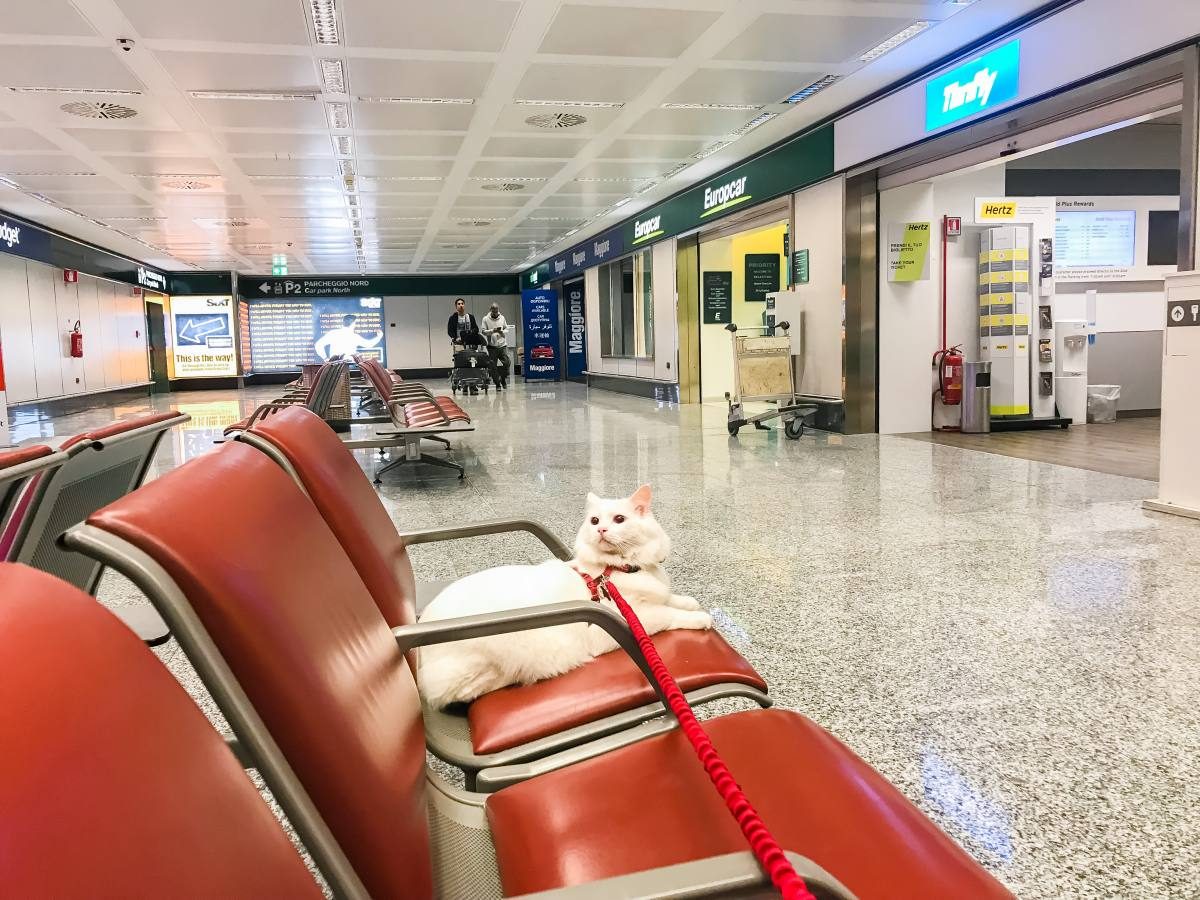
My Experience Traveling with a Cat to Italy, France, Poland, Netherlands, Spain, Switzerland
Our experience of moving with a cat from the US to Italy, and then later to France via Switzerland, was pleasant and easier than we imagined.
However, we’ve traveled with Poofy numerous times before, so we knew what to expect from the flying itself. He doesn’t mind traveling by plane and being in the car, and he usually enjoys looking at his surroundings at the airport.
First trip to Europe – 2018
Basically, all we had to do was to schedule an appointment with a USDA accredited vet 10 days before departure from the US.
As we were traveling from Texas to New Hampshire and before and staying there for a week, we got an appointment in New Hampshire.
We gave the vet vaccine records, and that was it. The vet had to inquire about the number of his rabies vaccinations with his old vet, but it was just a matter of a quick phone call.
Once we got his health certificate filled out it was a matter of getting the stamp from USDA. The first time we did that we could have overnighted to the Albany, NY office, but as we were flying out to Milan from NYC (it was cheaper and the flight was direct) we decided to schedule an appointment and stop by on our drive.
They scheduled our appointment very easily and we spent about half an hour waiting for the paperwork to be checked and stamped. At the airport, we processed the check-in and apart from paying the pet fee, no one ever asked us to show his documents. We usually book window and middle seats when we travel with Poofy, so he can enjoy some privacy, but this time, we got upgraded to Delta Comfort seats and had to sit in aisle and middle seats.
The cat didn’t seem to mind and as usual, he spread out on both of our laps and slept there for most of the flight before crawling back to his carrier for more naps.
When we arrived in Italy, we took his carrier and just walked out. No one asked us for cat paperwork at the immigration (in fact, we went through the automated one), or when we were leaving customs.
I heard it’s a common thing that you’re never asked to show any paperwork for your furry friend in Italy, but it’s better to be on the safe side and have it ready. They do check paperwork thoroughly when leaving Italy, not entering.
When we went to Poland on this trip, Poofy became a dual citizen and got his EU Pet Passport.
From US to France – 2022
Poofy has been to Europe back and forth a few times and moved to France with us as well later on. Only once we encounter issues, as the checking agent didn’t know how to process a pet fee or check his EU passport. It’s really a simple process, so don’t be scared.
Poofy has traveled around Italy, France, visited Poland, Switzerland, and Germany. After his first trip to Europe he doesn’t need a USDA certificate anymore, because…
From US to Poland – 2024
We actually had to redo the USDA paperwork (I explained it in EU Pet Passport post). Nobody checked a single paperwork at the counter in the US or upon arrival. They saw the cat and didn’t ask a thing.
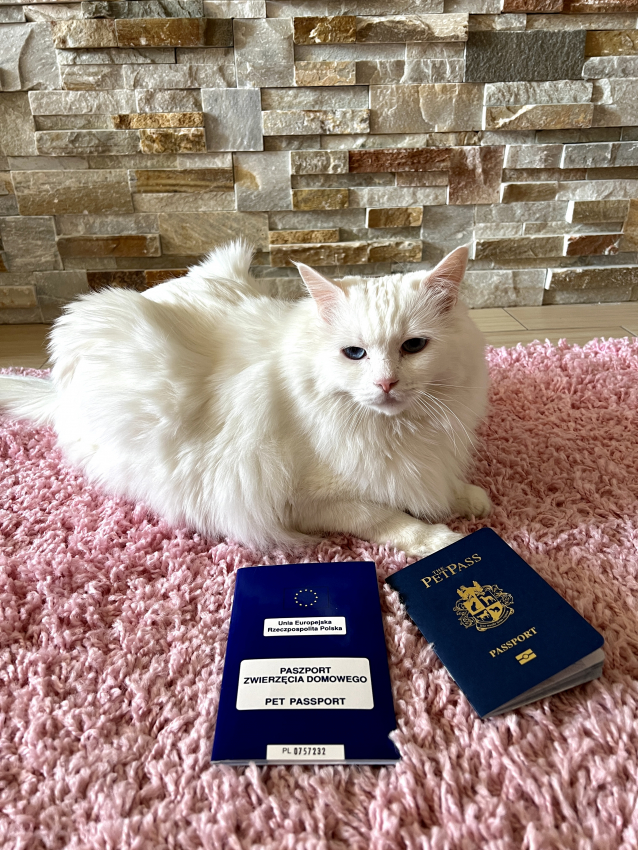
Returning from Europe to USA with your Pet
You don’t need anything to get back into the USA from Europe with your pet as long as the rabies vaccine is still valid.
At first we were told not to use our Global Entry, but the next time, we were told it’s fine to use Global Entry when you re-enter with your pet.
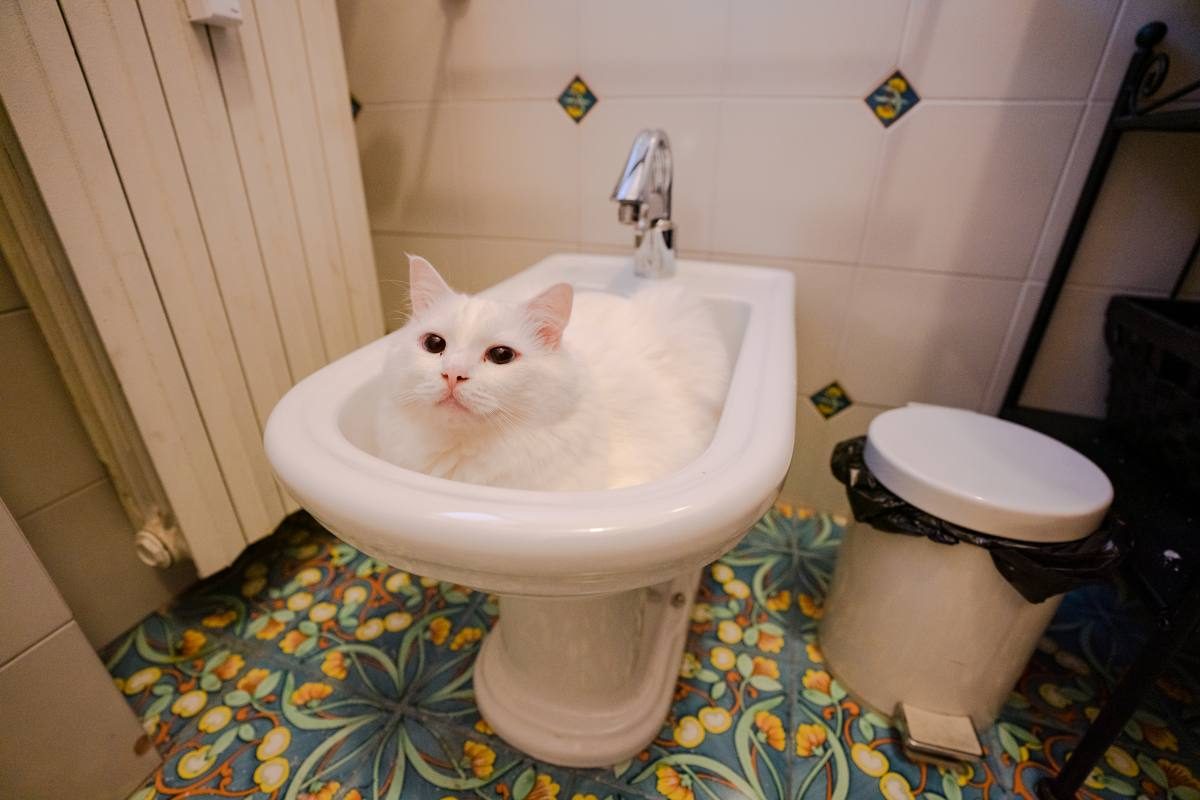
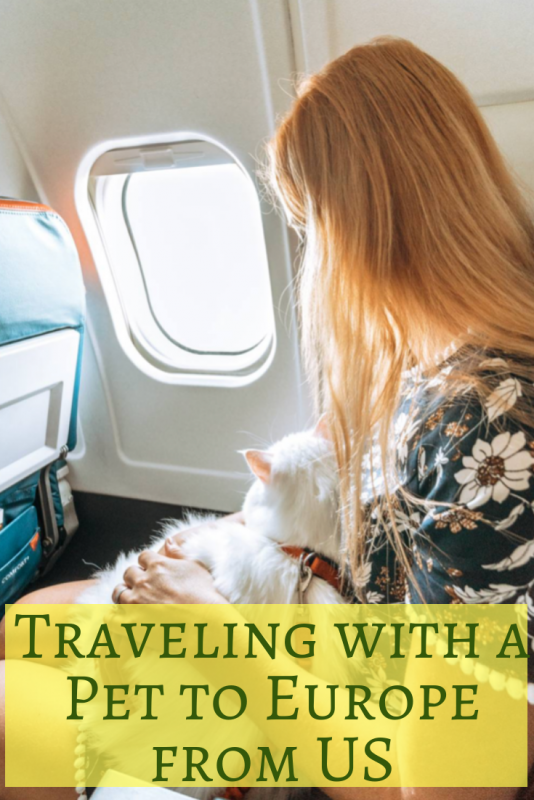
Do you have any questions about transporting your pet to another country? Ask ahead!








Such an interesting post! Thanks for sharing!
Thanks for this info! We’re planning to go on a Christmas vacation with our pets and this post really helped me. 🙂
Does it apply to all kinds of pets or only specific to some of them?
Small dogs, cats, birds and ferrets. Rabbits are slightly more difficult sadly.
Really great tips! There’s so much that goes into traveling with a pet that I never thought about.
Interesting info!
But just a heads up, the US is NOT considered rabies-free: https://www.pettravel.com/passports_rabies_free_countries.cfm, https://www.cdc.gov/importation/rabies-free-countries.html
(I know this because of an obsession with rabies I had a few years ago. I was convinced I had it after I got bit by a rat. Fun times!)
It’s treated like a rabies-free country, hence no quarantine apart from Hawaii 🙂
Thank you so much for taking the time to share your experience!
Did I miss something? Why did you guys move to Italy?
Because why not 🙂 We wanted to go to Europe for a while.
Which airline you used to fly from the US to Europe? Delta seems not to allow cats to be outside their carrier on the flight, if i read rules correctly.
Delta and Alitalia. Officially nope, but flight attendants always love him and want to see him 🙂
Hello Anna,
Thank you for all these informations.. im planning to take my 10 years old cat to the states. Can you help me knowing the US rules ??
Sure, but the rules vary depending on where are you coming from.
Very helpful info on flying! I’m planning on spending 3 months in Italy with my 2 cats and I’m having the hardest time finding accommodations that will accept cats. The ones labeled as “pet friendly” seem to only allow small dogs when I look further into it. Would love to hear any advice you might have on this. Thanks!
Sadly, as you say: lots of places are very discriminatory towards cats and the pet friendly often dogs only. Call and tell them that your cats don’t scratch, that they’ve traveled before and basically convince them if they’re claiming they’re pet friendly. But Italy isn’t usually as difficult unless it’s Positano.
Hi Anna great post! Thank for all the good info. We are traveling with our dog to Bulgaria this summer and have a layover in Germany I guest i need to find out where to pay the second pet fee. He has been vaccinated for rabbles at 13 weeks old and then micro chipped at 9 months old. My question is- do we need to boost him or he is ok like that? Also the link for the USDA form is not active on the post. Thanks
How old is the dog now? There’s been a recent change and various places require yearly rabies to travel.
@Anna Karsten, sorry i forgot to mention that. he is 11 months old and the time of departure will be 1 year and 3 weeks old.
@Anna Karsten, Hi I forgot to mention that he is 11 months old and will be a little over a year at the time of travel. Thanks
Hi Anna,
Thank you for your post! It removed part of the anxiety produced by leaving lady Diama in the US while we go to Europe.
I have a question regarding bathroom at the plane? How do you manage?
Thank you!
Most cats won’t go at all until you get to the hotel no matter what. At the airport you can set up a portable litter box (more info: https://annaeverywhere.com/how-to-travel-with-a-cat/ ) but honestly again – most cats won’t go.
Hello, I also have a dual citizenship (US and Croatian) and I am getting a ragdoll cat this month…we travel to EU every year and was just wandering if we should vaccinate our pet in EU if we get her a EU passport there? Because I don’t think US rabies vaccine is going to be valid for EU pet passport, unless endorsed. Thanks
Where are you getting a ragdoll? In the US or Europe? If you’re getting the cat in the US you will need to vaccinate your cat in the US, because otherwise she won’t be allowed to travel to the EU. If your Ragdoll is from Europe then you can do the vaccines and microchip in Europe. If you’re getting your cat in the US then you will need to get the cat’s documents endorsed by a USDA-approved vet to travel to Europe – then you can get a pet passport. According to European laws your travel cat needs to receive rabies vaccine every year now – we do some in the the US and some in Europe and it’s not an issue, but the first trip is the only tricky part.
Anna, thanks for your really helpful posting. We are from the EU and our dog has an EU Pet Passport. We are currently travelling in the US and have brought our Chihuhua, Blu, with us. I think from what you have written that when you return to the EU from the USA with an EU Pet Passport that you don’t have to provide the USDA check – have I read that correctly? Do you have to get any vet checks when returning to the EU in your experience? Unfortunately the EU sites are particularly clear on this specific point. Thanks, Adrian. P.S. We flew KLM with Blu in the cabin and the airline and staff dealt with Blu very smoothly.
That’s correct – if your dog has an EU passport you just show them this. No vet checks are required as long as her/his rabies is up to date (something has changed and it’s not yearly for various countries in the EU).
Hi there! I don’t see the link to the USDA site to download the form you took to have the vet sign. Could you please share it? Thank you!
The link is under step 3 🙂
Also– I noticed there was nothing you needed to do upon returning to the US and just wanted to check if that was still relevant in 2022. Thank you!
Absolutely still relevant. Entering the US is basically just rolling with a pet like with luggage. If you have Global Entry, you just walk in. If you don’t, they might ask you if you have a pet and might take a look at him but that’s it.
Great info! Thank you!!
Happy travels ☺️☺️
Hi Anna,
I’m traveling with my cat for the first time in 2 weeks. We are from Italy and traveling to USA. He has a pet passport with all the rabies and microchip info. The question I have is for the health certificate. He got one the end of October when we applied for the passport. Do I need to get another one from the vet 10 days before we fly to the USA? Or is this one still valid? It seems like I do not even need it for the USA but then some say I do. Coming back I believe I just need to show his EU passport and that is good. Hope that makes sense. The airline keeps giving me different information. Any info would be helpful. 🙂
Which airline are you flying with? Technically speaking you don’t need it, I don’t remember the last time we had to get the certificate honestly… everyone just looks at his passport.
@Anna Karsten, Hi, we are flying with United. That’s what I thought because the cdc said for cats they don’t need info except rabies. First time flyer so I’m making sure I have all the correct info.
Thank you for this post – it’s super helpful! My daughter is bringing her cat from the US to Bergen, Norway, where she’s currently living. She has a layover in Amsterdam – how can we find out if she needs to pay a new pet fee? What should she be aware of? She’s pretty nervous to fly with him and we’re hoping to be aware of every eventuality. Thank you so much!~
(second question) She went today to get his rabies booster and because she didn’t have proof of his very first rabies shot, they aren’t counting his last one as a 3 year rabies and saying it was only a one year one, meaning the booster is now being counted as a regular shot and won’t be 21 days before traveling. She’s called the airport in Norway and they will quarantine him for the remaining days until it’s been 21 days, but will she be able to prove that somehow in Amsterdam at her layover – will they allow him to continue on?
If there’s no proof of the last vaccine (although how come? every vet must have the record in their books). Has she obtained the EU health certificate by a USDA veterinarian? Not everyone will fill out the paperwork considering the cat doesn’t have a valid proven rabies shot.
The documents of her cat will be checked in the US and that’s the most important part. Call the airline to make sure that they’d even let her fly.
P.S. I would be careful with counting on quarantining the cat in Norway… my friend had to do this because she forgot a shot and thankfully it was just for a day but spent over $700 PER DAY for a dog for the quarantine hotel. She was left with no choice because otherwise, they’d put the dog down.
@Anna Karsten, yes, we called and it’s $30 usd per day. She did get the paperwork, but it’s not certified, they’ll send it when it’s been 21 days. We called Delta and they said that since she’ll have the paperwork in hand, it should be fine to get on. The lady we talked to in Norway was super helpful, we’re just mostly concerned about what will happen during her layover in Amsterdam.
That’s great news that it’s only $30 a day for her cat.
Hi Anna,
Thank you for the useful information. Do you know whether an airline can tell that the cat does not have enough space to move around in the carrier and hence won’t let the cat on the plane? The cat is less than 8 kg but quite big in size.
My cat has flown over 50 times and not once they cared about it (and since he’s a Ragdoll he’s actually huge). They weighted the carrier a few times and since he’s right at the weight limit one lady gave me a look, but that was it. That said, doubt it’s an issue as long as your cat fits in the carrier no one ever looks inside unless they want to see a “pretty kitty” and I let them pet him 😀
Hi Anna,
I have travelled for many years LA to Rome with my dog who is 26 pounds.
Every year I get the paper work and it goes more or less smoothly. He travels with me as a service animal since they took away emotional support animals. My question for you is regarding air travel within Europe. Lets say my next flight is LA Paris Bologna. Would they let him fly with me Paris Bologna? I would freak out if they tried to put him below with the luggage.
To answer your questions correctly I would need more details, but most importantly what kind of service dog is he. Because for instantly, most non-US airlines don’t allow psychiatric service dogs on flights that aren’t to/from the US. You also need to inform most airlines that you’re flying with a service dog at least 48 hours in advance (in some situations 96 hours) and might be asked to provide documents for him and you might need to prove the behavior in regards to staying calm and not relieving herself. Generally, it varies per airline rules.
Hello! We are planning on moving to the UK next year and trying desperately to find a way to not have them put in cargo. The only solution I can think of at the moment is to fly to France and take the ferry to the UK, but I wasn’t sure if that was allowed or if there were any other regulations I should be aware of. Do you know anything about traveling to the UK with cats from mainland Europe? Or do you have other thoughts about how to get our cats to the UK?
Flyign to France and crossing on a ferry (or eurotunnel) is your best option. Once in France, you can get them an EU passport to make things easier – https://www.gov.uk/bring-pet-to-great-britain/listed-and-unlisted-countries
Hello, did you need rabies titer test done before traveling from US to Europe? I am reading that it may be required 30 days after rabies vaccination but no more than 3 months before traveling to EU.
No, just the vaccine.
thanks for all your detailed sharing. Such a fun post and Poofy sure is a mellow happy traveler. Ive been putting of traveling back home to Italy with my cat Tiggy for 2 years.
He is NOT a good traveler and can’t even manage a 10 minute trip to the vet with out massive drama. Originally, 8 years ago I brought him here to California via cargo ( he was born in Itay) Now its time to go back. here in my state of CA during covid and since no appointments for the USDA stamp are allowed. You can only receive your embossed copy by mail which timing wise does add some stress. However if your vet is set up with
the VEHCS electronic system you can at least upload it directly and if your country is not coded for a hard copy, you can also receive it back vis the electronic system. I have just been told that since the vet health certificate is valid 30 days…it is possible to send the documents earlier than the 10 day window required for the USDA stamp….as long as the stamp approval is issued and dated no earlier than 10 days , you just give your flight dates . I cannot absolutely vouch for the yet as it is not written on the USDA website. But that is the info in California anyway.
An amazing article. My boyfriend and I are considering moving to the UK in a few years but we wanted to get a dog! Would there be anyway to avoid cargo the whole way to UK. If we got a small dog, do you think it would be best to fly first to a country in europe that allows the dog in the cabin, then do a short transfer flight to the UK with the little pooch?
To avoid the cargo you’d need to go by car via ferry or Eurotunnel to the UK from France, because animals in cabin – no matter how small, aren’t permitted AT ALL in the UK, regardless of where you’re coming from.
Girl. respect! Well done! Keep on going, Wish you the best!
Thanks for this most helpful article. I am mostly concerned about my cat “Alfie” because it has been very stressful for him when we only drive 5 miles to his vet. Is there something I can get for him to calm him? I just got back from Rome and the flight with one connection was 16.5 Hours.
We’ve never given our cat anything, because he’s calm but my previous cat would meow for hours no matter what… some cats are just like that and the only thing that helped her was giving her snacks.
Hi Anna, thank you so much for sharing your experiences, it is very helpful!. My cat Ciara walks on a leash everyday, loves to ride in the car and has flown from the US to Chile and back twice now and she does great in planes and airports as well. However, we are planning a vacation to Italy and we were skeptical, not sure if taking her with us would be too complicated or inconvenient, but after reading your post I feel really good about taking her with us. Thank you!
That’s exciting, enjoy!
@Anna Karsten, Thank you for your wonderful and helpful article . SO inspiring. I have lived over 50 years in the Us but now at age 69 I wish to return to the UK . of course I would not dream of going without my cats. The problem is that I have one 15 ib siamese rescue who is similar to your cat. he walks an a leash, loves the car , going to the store, people etc. he is happy as long as he is with me . However his tabby( 10 lb)( bottle mate sister )is skittish , will not walk on a leash and always prefers to stay at home. I don’t know what would be best . I have travelled extensively abroad but never with them. I considered taking the Queen Mary where they could share a kennel but they are not allowed out the entire trip ( unlike dogs) which sounds awful. I thought about taking a flight to Amsterdam ( cats with me as carry on ) and then the ferry from there to Newcastle . I don’t know how I would manage 2 cats at once though The othe3r choice is to send them in cargo together direct to Heathrow. I am sick with worry . I cannot bear the thought of them being frightened or unhappy . I could make 2 separate trips with each cat . Please tell me your thoughts . I am reasonably fit but don’t think I could carry 2 separate cats and carriers as it would be so heavy . Thank you, Janet
Anna – what a great post! thank you the very pragmatic information. We are thinking of taking our 2 small Yorkies (4lbs and 7lbs) on an extended stay in Europe next year, and you post has encouraged to explore this option. We will definitely not place them in cargo – ever. We live in LA so the only direct gateways appear to be FRA, AMS or CDG. (maybe Zurich).
One question tho : why not allow them ‘upfront’ in business class?
It’s mostly because it’s not possible to put a kennel underneath the seat in front of you. In your case if you want to fly business or first class your best (and if I’m not mistaken only) bet is Lufthansa because they’re one of a few that allow pets in business, but there are limits so you might not be able to do it with two dogs.
Hi,
When you go to Europe, don’t you need any import permit?
Only the paperwork I mentioned.
Thank you SO much for this. It all seems so daunting, so I really appreciate it. We’re planning on going to France together for study abroad for a couple years and I definitely want to bring my cat with me.
Currently in planning phases for the fall, so I really appreciate it.
I am picking my Ragdoll kitten in Poland and bringing it to the USA. My understanding is that kittens before the age of 16 weeks do not need the rabies vaccine and will only be inspected at the airport on arrival in the USA. The only thing I will need is to complete the online certificate you linked. Is that your understanding as well?
No, the certificate is to go the other way (from the US to Europe). You are correct, the cats are no longer required to have rabies vaccine or health certificate. Poland doesn’t require an export certificate either. However, different states might have extra requirements so make sure to check that too.
Our small dog got her pet passport in France and renewed in Netherlands twice. To the UK they did allow pet in cabin for a large fee if they were an ESA – not sure if they still do. Otherwise you can take a ferry or a car ride through the chunnel to the UK from the EU – the Netherlands to Newcastle and Hull routes allow you to book a pet friendly room. To the UK they just need a tapeworm treatment roughly a day prior. We travelled on United several times and Lufthansa business class Denver to Frankfurt with no issues. The soft kennel stuck out a bit but they had no problem with it. We have only once found a customs officer to show the passport to in Germany and they seemed annoyed we had asked. Also note some railways in Europe don’t allow pets in first class (Czech) – we didn’t know but kept her quiet and had no issues. Pet passports are great but you must have the rabies renewed in the UE, so it is only lifetime as long as that is done there – no US entires.
It’s reassuring to know that the process of traveling with a pet isn’t as daunting as it may seem, especially when one plans carefully and adheres to the necessary requirements.
Your mention of the EU Pet Passport is particularly interesting. It’s fascinating how some European countries have more straightforward processes, while others may require legal residency or citizenship. Your experiences with Poofy’s travels emphasize the significance of knowing the regulations thoroughly, even if they aren’t always strictly enforced. It’s always better to be prepared to ensure a smooth journey for both the pet and the owner.
Thanks for sharing your insights and experiences with pet travel! By the way, Poofy sounds like quite the adventurous feline!
Cheers,
Femi.
Hi
I might be traveling to Switzerland in June 2024 and staying for 3 months at least and possibly moving to Europe. I am trying to register my American Pit bull terrier as my service dog and she is being trained soon.
I will make sure microchip is correct according to this email and even though had 3 year rabies can do again if the microchip she has is not the one in this article. Not sure about the USDA thing, does the vet take care of that? I thought service dogs could just travel anywhere as long as there certified and they have shots up to date?
Any tips for me? I would be traveling from either Washington state or Arizona.
Thanks
Melissa Clem
[email protected]
Only certified vets can take care of the USDA thing, not every vet has this ability. Every country has different requirements in regards to service animals, but most still have to meet the same entry requirements as pet dogs.
One thing to make sure if is check ALL regulations. For example, Switzerland forbids import of dogs with docked tails and that applies to service dogs too so it gets tricky.
Is there any way to travel with a 50lbs dog from us to europe, with him not being a cargo, but travelling with us?
Like how about emotional support dogs, or special airline companies, or how about sailing? And/or what else is possible?
He is recently adopted and i wouldnt put him through that process of being a cargo.
Emotional support dogs aren’t eligible to fly on most airlines anymore and Europe doesn’t acknowledge them anyway.
There are various private airlines that sell tickets to pet owners – like https://www.k9jets.com/ for example and it’s your best option. Alternatively, you can cruise with your dog on Queen Mary but it’s multiple days and he’d have to stay in a pet kennel while you can visit him daily for a few hours which honestly doesn’t make it better than cargo and then you enter the UK which also creates issues.
Hi, I live half of my time in the States and Greece. I have a Yorkshire terrier who always travels with me and he has his EU passport as well. However, I am looking to see if it’s not necessary to get the USDA International health certificate if I go for just 3 months or less in Europe?
No because he has an EU passport so he can go back.
Hi Anna, I’ve brought cats back and forth between Ireland and the US a few times but the rules keep changing so I thought I’d check with you (so grateful for this blog). We live in Cork 9 months a year and South Carolina three months. I’m currently waiting another week before my kittens rabies shot is valid and then I want to bring him to the US. He’ll have an EU pet passport. I want to avoid cargo and the expense of a professional handler. I’ve been told Aer Lingus and American/Brit Air won’t allow pets in the cabin but Delta/United and KLM will. Is this your experience? If I book my flight out of cork, it will have two legs at least—cork to Amsterdam and them Amsterdam to the US. Do I have to book my car on both flights separately? Just wondering how to coordinate this. What if I get him on one flight but the second ends up being booked up w pets? When I get to Amsterdam will I need to pay another fee in the airport for the layover? I’m a little stressed because from prior experience the rules seem to change frequently and people at the airport are often unsure what to do. Also we have a large hard carrier now. What would you recommend for in the plane? Thank you in advance! Leah
Great question honestly, because normally when you check pets in cargo you don’t pick them up on your layover, so it’s something you would need to pre-arrange with KLM directly but they’re great with pets so shouldn’t be an issue.
Hard carrier for the cabin won’t cut it, because they might not fit under the seat unless it’s even smaller than the max. dimensions (and most hard carriers aren’t). Get a soft carrier for sure, but then for cargo you need a hard carrier which makes things weird and the reason why we rules Ireland as a potential place to live in Europe despite my husband being actually a citizen 🙁
Thank you for such useful information! I have one important question, I heard that from Italy specifically back to the USA you need an export documentation? Is that true? Thank you!
Not that we were ever asked for anything extra.
Great post! We just traveled from the US with our 3 small dogs and have been in Croatia but now we’re in Montenegro for 3 months before we go to Amsterdam then back to the US. I was under the impression our certificate would be valid for our whole trip but from what I’m reading it’s only 4 months? I’m now nervous about flying to Amsterdam since we’ll have been in a non EU country for 3 months. Any advice? I’ve tried searching but can’t find anything that fits our situation since we can’t technically get a EU passport as we didn’t stay past the tourist visa before moving to Montenegro. Wish my vet would have told me we’d need to do something additional before coming back after 6 months but he made it seem like the health cert was all we’d need. 🙁
It’s correct, the certificate is valid for 4 months only. If you’re staying longer you basically should have gotten an EU passport for them. Your certificate won’t be valid anymore, so you won’t be able to fly to Amsterdam with it I’m afraid. You’ll basically need to go through the whole vet certificate again in Montenegro.
The worst news for you isn’t that you might need two separate certificates – because Netherlands (or EU) doesn’t consider Montenegro to be a low-rabies risk, but the US does. When a country isn’t a low-rabies one you’ll also need to get a blood sample to prove rabies antibodies and send it to an EU lab. It’s a process, won’t lie. Call border patrol if they let you bypass it on a quick layover, but if you were planning on staying in the Netherlands even for a day then you need a separate certificate to enter EU from a non-EU country.